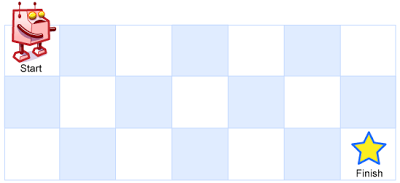题目:
A robot is located at the top-left corner of a m x n grid (marked 'Start' in the diagram below).
The robot can only move either down or right at any point in time. The robot is trying to reach the bottom-right corner of the grid (marked 'Finish' in the diagram below).
How many possible unique paths are there?

Above is a 3 x 7 grid. How many possible unique paths are there?
Note: m and n will be at most 100.
题解:
Solution 1 ()
class Solution { public: int uniquePaths(int m, int n) { if(m<0 || n<0) return 0; if(m ==0 && n == 0) return 0; vector<vector<int>> dp(m, vector<int> (n,1)); for(int i=1; i<m; ++i) { for(int j=1; j<n; ++j) { dp[i][j] = dp[i-1][j] + dp[i][j-1]; } } return dp[m-1][n-1]; } };
用一维数组存储,d[j] = d[j] + d[j-1];这里的等号右边d[j]相当于d[i-1][j],d[j-1]相当于d[i][j-1];
Solution 2 ()
class Solution { public: int uniquePaths(int m, int n) { vector<int> dp(n, 1); for (int i = 1; i < m; ++i) { for (int j = 1; j < n; ++j) { dp[j] += dp[j - 1]; } } return dp[n - 1]; } };
First of all you should understand that we need to do n + m - 2 movements : m - 1 down, n - 1 right, because we start from cell (1, 1).
Secondly, the path it is the sequence of movements( go down / go right),
therefore we can say that two paths are different
when there is i-th (1 .. m + n - 2) movement in path1 differ i-th movement in path2.
So, how we can build paths.
Let's choose (n - 1) movements(number of steps to the right) from (m + n - 2),
and rest (m - 1) is (number of steps down).
I think now it is obvious that count of different paths are all combinations (n - 1) movements from (m + n-2). (from here)
Solution 3 ()
class Solution { public: int uniquePaths(int m, int n) { int N = n + m - 2;// how much steps we need to do int k = m - 1; // number of steps that need to go down double res = 1; // here we calculate the total possible path number // Combination(N, k) = n! / (k!(n - k)!) // reduce the numerator and denominator and get // C = ( (n - k + 1) * (n - k + 2) * ... * n ) / k! for (int i = 1; i <= k; i++) res = res * (N - k + i) / i; return (int)res; } };